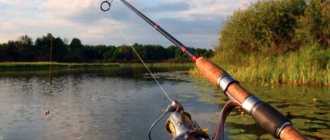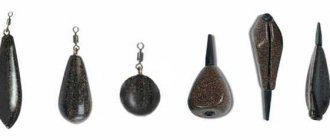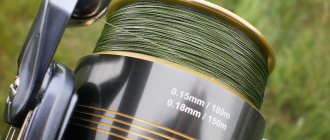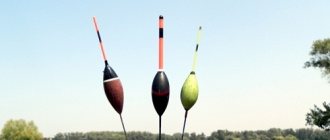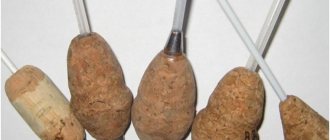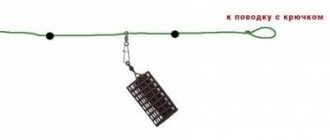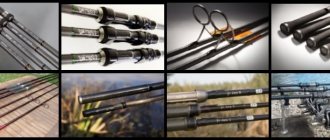You should remember certain features of fishing with a sliding float. For example, it is sometimes attached through a ring on a fishing line or connected using a swivel. In the first case, the main line may overlap with the hooks, and in the other, the type of installation to some extent prevents this phenomenon.
Then, it should not be lowered close to the hooks while casting. This can lead to overlap of the line, after which the cast will be unsuccessful and again you will have to deal with the resulting “beard”. To avoid adverse consequences, it is necessary to place a limiting clamp on top of the upper sinker (approximately 20 cm) to prevent the float from approaching the hooks.
Advantages:
- The loaded float makes it possible to place a small weight on the leash, so that the fish will not feel it when biting.
- It can be thrown under the edge of the reeds, since some types of fish (crucian carp, tench) prefer to be there.
- The ability to cast further and more accurately, since the thrown tackle has one center of gravity;
- Less susceptible to wind drift, risk of drowning the fishing line;
- Possibility of changing the float and loading in one motion;
- Greater sensitivity (unless you take a plug, of course)
- If you attach a large weight, it will be able to hold the bait quite firmly near the bottom.
Flaws:
- It is impossible to catch “hold” because the float begins to sink.
- During windy weather, accuracy and casting range decrease.
Float selection
Main types of sliding floats:
- With a central axial hole for passing fishing line, it has a voluminous body and large load capacity. The advantages include ease of installation and ease of casting.
- With two ears on the body for passing fishing line, it has high sensitivity characteristics and is quite stable when fishing in strong currents. The downside is that the lugs are of poor quality and often fall out of the body or bend when hooked.
- With one eyelet for fastening, they are excellent floats when fishing in still water and for long casting during match fishing. Using an adapter, it is quite easy to remove and change another float. In the first two options, the floats are changed only when the equipment is completely disassembled.
Conventionally, according to their form, they are divided into three types:
Round, used for casting over short distances in calm weather.
Oval, used for medium distances with small gusts of wind.
Extended, designed for long casting in very windy weather.
A light float is not suitable because it slides extremely weakly along the fishing line. It cannot withstand such a weight of weight that the line will slide through its eye without obstacles when the bait drops into the water. Smooth thin monofilament fishing lines usually use a weight of up to 5 g. Then the traction will be sufficient.
The bait should drop quickly so that the moment when the stopper touches the eye of the float is clearly visible. A float with a load capacity of 8-12 g will not become very heavy. On the contrary, in deep water when catching large fish (for example, bream), it is more practical.
How sensitive a float is depends not on its size, but mostly on the thickness of the antenna and how far it sticks out of the water.
The required quality is sufficient self-loading. If there is not enough weight at its base, it will not fly in sync with the load when casting.
Correct loading of the float on crucian carp
Correct loading of the float
You've chosen a good and sensitive float, but that's only half the battle. It is important to load it correctly in order to fully extract all its benefits. The most correct loading option is for the entire tip to be visible from the water. Thus, the entire volumetric part is under water and when a crucian bites, the resistance of the float is barely noticeable, because only a thin tip is above the water.
How to properly load a float? At home, the easiest way to load it correctly is with a 1.5 liter bottle. Pour water into it, lower the float a little and lower it into the bottle; if the float is not loaded enough, hang another pellet and again observe whether only the tip is visible from under the surface of the water, or whether there is also a significant part of the body itself. The body should be completely under water.
[THERE IS AN ANSWER] How to catch a large crucian carp among small ones
Use thin-nose pliers, wire cutters or scissors to cut off excess pieces of the sinker if you suddenly load the float with excess weight.
In nature, you don’t need any bottles. Just load it up and constantly test it on a pond. You don’t have to take the hook and bait into account; they weigh practically nothing, and together they often balance each other out.
We fix the float to the tackle using cambrics. Cambrics (pieces of silicone tubes) will firmly press the float to the main cord and prevent it from slipping. Before this, the fishing line is inserted into the eyes of the rod. Well, or with the help of stoppers, as in the picture below.
Main components of equipment when using a sliding float
How successful fishing will be using a float rod depends on its quality. Using rough and heavy gear, you can quickly get tired and lose interest in the process. The fishing rod must be properly equipped.
Sinkers
Some fishermen use one sinker, without underweight, which is incorrect. Using one weight, the tackle will become vulnerable to snags and impractical when fishing with a retrieve, but it will be useful for fishing in still water. When fishing downstream, the load is placed in descending order.
Loading in such equipment is performed using a similar technology with blind equipment. One has only to take into account that the upper main sinker serves as a lower stopper, since it must be clearly fixed on the fishing line to avoid slipping as much as possible. It is recommended to install a short silicone or rubber tube or bead on top of the main weight. They cushion the float to prevent damage to the fishing line.
There are certain types of loading for sliding floats. The most popular and durable, according to most fishermen, are the usual methods of mounting the component loads - pellets or “olives”.
fishing line
The choice of fishing line for equipment depends on the type of fish and casting distance (they use a heavy float with a large load capacity, so the fishing line is chosen thicker). The leash is always much thinner than the base.
From above, the fishing line is threaded through a wire eye or passed along a channel in the body. A float with an internal channel is most resistant to heavy loads, and therefore they are better suited for strong currents.
To avoid the appearance of a “beard” during casting, certain rules should be taken into account when equipping gear. For example, the stiffer the main line, the easier it will be for the float to move along it.
The best option would be to use a special fishing line for match fishing with a diameter of 0.18-0.20 mm. The main weight should be located below the float. If everything is followed, then after casting the bait will sink to the bottom faster.
Swivels
A swivel is a small special device that is part of the equipment that prevents the line from twisting. In particular, it is indispensable in fishing with spinning rods and spinners. A large spinner extremely quickly twists the fishing line in such a way that its strength indicators are reduced by almost 30%. During the casting process and its constant winding onto the round spool, involuntary twisting occurs.
The advantages of a swivel include preventing strong twisting of the fishing line, as well as maintaining its strength. Of course, a completely new swivel will not be able to preserve it, but it will help to significantly reduce the harmful effects of twisting. Carabiners with clasps are extremely convenient for changing baits, and in a spinning bait this is a fairly significant quality, since with a bad bite you need to try a considerable number of baits.
The disadvantages include the fact that a large swivel impairs the performance of the bait, for example, certain wobblers. Therefore, small swivels are predominantly used.
The swivel is tied with the simplest fishing knot: the fishing line is threaded through the eye, which is now in the loop. Then twist it with your fingers several times. Afterwards, the free end of the fishing line is threaded into the loop. The knot is moistened and tightened. If the end of the knot is too long, it is cut off.
Motoviltsa
To wind up the finished equipment, you will need a reel, and for their subsequent fixation, metal hooks with elastic bands. The hook clings to the thin crossbar of the reel, then the fishing line is wound with weights, after which a metal hook with an elastic band is threaded into the upper swivel, securing the tackle. On the side of the reel, with a marker, make a note about all the data on the tackle: line diameter, sinker weight, hook number.
Reel-mounted rigging is preferable because it makes it possible to rig a match fishing rod extremely quickly. Arriving at a pond, often, a fisherman simply threads the fishing line along the ring of the rod, then attaches a float (blind or sliding), and then attaches it to the main fishing line. The length of the rig depends on the minimum fishing depth. Taking this into account, the length of the winding equipment should be at least a meter.
Other components
Other components of the sliding equipment also include stoppers. The main task of the stopper is to fix the float on the fishing line while lowering the equipment.
Taking this into account, the following requirements are put forward to the stopper:
- Free, unhindered sliding along the rod guides.
- Reliable fixation of the depth of descent of the equipment, and at the same time should not be fixed tightly.
- It should sit firmly on the line without slipping or unraveling.
Stoppers come in rubber (silicone is one of the most ancient) and thread stoppers.
The stop knot is not put on the fishing line, but is knitted during the production of the equipment.
It should not slide along it, but at the same time it should be clearly fixed. There is an important requirement for tying these knots: the ends of the knots are not cut very short. The long end slips through the rod much easier.
Installation of equipment
- One or two (depending on the slippage of the float) stoppers are threaded onto the fishing line.
- The float itself is put on.
- Then one stopper is strung in order to limit the movement of the float along the fishing line. This lower stopper is brought close to the upper one.
- Then the weight is installed using replaceable weights so that only the antenna is visible on the surface of the water mass.
- Finally, the end of the main line is connected to the leash and hook.
There are several equipment options:
- Sliding olive rig: most effective in light currents. A sliding “olive” is put on the fishing line itself. A hook is tied at its end, and between them there are 1-2 small locking pellets. Depending on the depth and current indicators, the weight of the olive is determined. It makes it possible to fish in a strong current with a weak bite with long leashes, which is often important.
- Rigging with a “lollipop” type float: it is a balsa disk from which there is a metal keel and a plastic antenna. Such a float is unsuitable for fishing with small holds. If it is used using conventional wiring, its advantages will be reduced to a minimum.
- Equipment for wiring by dragging along the bottom: dictates more stringent conditions. This method is used primarily in deep water. First of all, because the sinker, dragging along the bottom, weakens the speed of the retrieve, and some types of fish (carp) bite on slow-moving bait.
Gear collection in general
Recommendations for choosing gear:
- The choice of line depends on the fish you want to catch and the weather conditions. For example, grayling is caught with a fishing line of 0.20 - 0.30 mm. In shallow water, when fishing with a light lure, use the thinnest line; and in deep-sea reservoirs, a thicker line is required.
- The diameter of the fishing line depends on its quality. It is necessary to remember the rule: the sum of the diameter and height of the throughput ring does not change.
- Rotating spoons are considered the most universal, followed by oscillating and wobblers. It is preferable to have several types of the same brand, varying in weight and color.
- The bait is chosen at the request of the fisherman. The choice of bait weight in a given body of water depends on the depth and other factors (casting distance, casting speed, etc.).
Gear collection:
- A sliding float is attached to the fishing line of the fishing rod. Then, a small bead. After that - a sliding sinker. Next is another bead. The first is necessary so that the float does not break on the sinker, and the second is necessary so that the sinker itself does not damage the assembly.
- A loop is knitted at the end of the main line using a double knot or figure eight. A leash is attached inside the loop (the thickness is 0.1 mm less than the fishing line), which is made from a very thin fishing line. The leash itself reaches up to 20 cm in length.
- All that remains is to install a stopper that prevents the float from moving freely along the line. The most effective and simplest way to do this is to tie a stopper knot. It is compact, easily passes through the rings and carefully stops the movement of the float in the right place.
Loading for strong current
Adjusting the position of the float in the current is one of the most difficult. Since here it is important not only to immerse the float in the water, but also to ensure that it reacts minimally to current movements and does not make false signals.
How a float behaves in a current is best shown in the video on how to properly load a float.
Float shipping options for current:
- A large pear-shaped sinker is used to hold the bait near the bottom.
- The weights are evenly distributed at the bottom of the line. About 70% of the weight falls on a segment of 70-100 cm from the leash loop. The rest of the sinkers are installed 40-60 cm lower. The auxiliary weight is attached close to the leash loop.
Technique of use
Having completed the assembly, the next important point is casting. You should not make sudden movements, try to give the line uniform and continuous acceleration. If the cast is made correctly, the float will fly forward and drag the rig along with it in tension.
Do not forget about slowing down the flight of the equipment. If you fuss, the risk that the float and weight may become tangled will increase. If fishing is carried out using a match rod, then you need to control the line coming off the spool while casting. For these purposes, before the rig falls on the water, you need to touch the edge of the spool with your finger and slow down its flight so that it straightens. Then the edge of the rod is lowered into the water.
During calm, windless weather, you should wait until the tackle is completely immersed in the water. If the wind blows to the side, then the line should be submerged so that it passes through the float without obstacles. The fishing process itself is not fundamentally different from fishing with a fixed float. Certain difficulties can arise only with measuring the depth.
If the weather is calm and there is no current, then measurements can be taken using assembled match equipment. The required depth at which the weight will lie on the bottom is achieved when the antenna is on the surface of the water. You should also remember an important rule: do not tighten the stopper until the depth has been completely measured. Otherwise, in the process of moving the knot there is a possibility of damage to the fishing line.
It is necessary not to lose sight of the casting distance. To determine the constant value of this characteristic, it is worth putting marks on the fishing line using a waterproof felt-tip pen.
How to properly set up a bite indicator for crucian carp
When biting, the crucian carp feels the heavy weight of the sinker. He gets scared and spits out the bait. A few small weights evenly spaced throughout the rig will help you avoid trouble. When shipping, about 1 cm of the float antenna should remain above the water. Everything else is submerged in water. If the angler knows how to properly load the float onto the crucian carp, he will receive maximum sensitivity of the bite indicator.
The right float for crucian carp
Setting the float for roach
Roach bites are accompanied by drowning of the float. Its minimal resistance allows you to clearly detect even the most careful bite. When fishing in the lake, one pellet is used. When there is a current, it is recommended to install several pellets at a certain distance from each other. The float body is completely submerged. A small part of the antenna remains above the water.
Setting up a float for carp
When fishing for carp or other large fish, the shipment is carried out using a grappling hook. This makes bites more noticeable. The main difference between this method is sensitivity. Having grabbed the bait, the fish will have to lift the entire weight of the equipment at once. She gets scared and spits out the bait. When using a feeder, it is enough for the carp to disturb a smaller part of the load, which is immediately displayed on the float.
Fly rod setup
Fishing with a fly rod involves frequent casting and hooking. Often, small fish actively bite at the feeding point, preventing the bait from sinking to the bottom. Special attention is paid to shipping here. Small pellets are used. Depending on the situation, they are located at a certain distance from each other. The correct placement of weights sinks the tackle at different speeds. The bait will quickly pass through depths where bites are not expected and slow down at the depth of interest.
So, the most popular among fans of sports fishing for crucian carp since ancient times is the float rod. Almost the entire success of fishing depends on its correct equipment. What is the use of excellent complementary foods and a full range of baits if the fisherman does not notice the cautious summer bites of well-fed fish? The fish are alarmed by rough tackle that does not meet the fishing conditions (activity and size of the fish; presence of wind, waves, currents; depth and transparency of the water; nature of the bottom and other factors).
Photos and drawings by the author
On summer crucian ponds, where in warm water the fish are satiated with natural food, we have often observed that even in these conditions, some fishermen successfully catch lazy and finicky crucian carp, while the majority are content with rare bites. Of course, this situation for losers can be created by errors in the selection of bait and bait, but most often this is determined by the incorrect construction of the float equipment specifically for crucian carp and the inability to control the tackle.
So, the most popular among fans of sports fishing for crucian carp since ancient times is the float rod. Almost the entire success of fishing depends on its correct equipment. What is the use of excellent complementary foods and a full range of baits if the fisherman does not notice the cautious summer bites of well-fed fish? The fish are alarmed by rough tackle that does not meet the fishing conditions (activity and size of the fish; presence of wind, waves, currents; depth and transparency of the water; nature of the bottom and other factors).
[THERE IS AN ANSWER] Which hooks are better for catching crucian carp
Compared to the well-known amateur equipment of a float fishing rod, sports tackle shows its undeniable advantage due to its ultra-high sensitivity to bites. This can be achieved due to the complex shape of the sports float, which has several points of attachment to the fishing line. This type of gear is easy to control, and the distributed loading system delivers the bait more naturally to the fish.
Typical equipment of a float rod with a blind (without reel) equipment for fishing in reservoirs with weak or no current is shown in Fig. 1.
Fig.1. Typical sports equipment for catching crucian carp: 1 - antenna; 2 - ring; 3 — float body; 4 - keel; 5 - cambric; 6 - fishing line; 7 - main load; 8 - under-grazing; 9 - leash; 10 - hook.
The second method is more complicated: you need to make a special float, which can be called a “needle”. Its design is determined by the following considerations. The wind drives only the upper thin layer of water, which slides over the lower, stationary or slowly moving in the opposite direction (wind circulation) layers of water. The rate diagram for such a process is shown in Fig. 2.
Rice. 3. “Needle” float: 1 — antenna; 2 - ring; 3 — float body; 4 - keel; 5 - cambric.
Closer to autumn, crucian carp no longer come out to feed in the shallow coastal waters, but occupy the main depths of the reservoir, which are often located several tens of meters from the shore. In this case, a sports float tackle for long casting will be very effective.
During the hot season in mid-summer, the situation is different: crucian carp splashes all over the reservoir, but practically does not bite from the bottom, and, probably, few anglers tried to catch it from the top with a slight descent, but in vain. Only the tackle needed for such fishing is light (the float’s load capacity is 0.4-0.8 g), with a distributed load so that the bait sinks as naturally as possible in the water column, and the loud slaps in the water with heavy tackle do not frighten the fish. The descent is usually set from 0.5 to 1 meter.
Each cast of the tackle should be accompanied by a small portion of light aromatic bait. After the float assumes a vertical position (the immersion wiring is completed), you should begin to perform short, smooth pulls on the tackle with periodic stops. The same fishing technique should be used when fishing from the bottom, creating a pre-fed “path” from the depths to the shore.
Equally important is the correct loading, which will allow you to use all the advantages of the selected model.
Float mount
The float is attached to the fishing line at one or several points. The difference lies in the specific requirements for the selected tackle, since the nature of the attachment radically changes its behavior when fishing.
- Single point fastening. It is the most popular mounting method, which makes it possible to maintain a high level of sensitivity of the float. This model easily changes its position, easily deviating to the sides. This fastening makes working with it easier, it is easier to remove it from the water, and the risk of the float getting tangled in thickets is reduced.
- Two-point fastening. More reliable when fishing is a float, which is attached to the fishing line at two points. It maintains a stationary working position both during casting and splashdown, and when retrieving and playing with the nozzle. The placement of the float on the fishing line can be deaf and sliding.
- A fixed mount does not mean that it is immovable. The float can be moved along the line, setting the required hook depth. This type of movement is achieved by moving stoppers or beads that restrain its movement. This is the most popular way to place a float.
- The sliding mount allows the float to move freely along the fishing line. Often this movement is limited by stoppers, which are installed in the required positions before fishing. It is used much less frequently than others, mainly on long-casting rods.
Adjusting the fishing float. The sinker must be very heavy in order to quickly deliver the bait to the required place and set the correct position of the float with its weight. It is immersed in water up to the waterline. It should be very small and extremely inconspicuous so as not to scare away the fish with its size and weight.
Loading a float for long casts
A fisherman who practices long casts uses a large amount of fishing line. Its length always exceeds the length of the rod. This can only be done if you have reels installed and special floats designed for long casts.
These floats can be easily identified by their appearance. Their center of gravity is shifted downward, and the antenna is slightly elongated. Sometimes the length of the antenna reaches forty centimeters. All this is done so that when casting, the float pulls the line along with it and prevents it from getting tangled. And this length of the antenna is needed so that the float can be seen from afar.
Now you can return to the correct loading of the float, the concept, types of loading. Now there are two main methods that can be used to distribute weight under the float:
This fish is not picky, but the best results are achieved by a master who has correctly set up the tackle, the key aspect of which is the float. In production, manufacturers use the following materials:
The advantage over feeder and bottom equipment is its wide range of applications. You can fish with a float rod in various conditions:
- rivers with slow and moderate currents;
- jet (for demolition or wiring);
- standing bodies of water: ponds and lakes;
- reservoir (from boat and shore);
- sea (from the pier or beach).
[THERE IS AN ANSWER] Which float is better for catching crucian carp
Float equipment is perfectly adapted to any body of water, so it can safely be called universal. You need to start searching for crucian carp at the edge of the reeds. A small portion of pre-prepared complementary food will attract and keep the fish on the spot. In artificial reservoirs, old maps will help you find prey. If you have a boat and knowledge about the flooded lake, the chances of success increase. Crucian carp is found more often in such places.
River fish are more active due to the current, but following the example of lake species, they prefer to stay in their homes. Fishing takes place while fishing. Floats for searching and catching crucian carp are used in the light class, because the bites are more delicate in the current.
Roach bites are accompanied by drowning of the float. Its minimal resistance allows you to clearly detect even the most careful bite. When fishing in the lake, one pellet is used. When there is a current, it is recommended to install several pellets at a certain distance from each other. The float body is completely submerged. A small part of the antenna remains above the water.
Blitz tips
- For any type of fish it is worth using your own sliding bobber.
- A sliding float, like other conventional types of floats, must be loaded.
- The sinker should weigh more than 3 g, and optimally more than 4-5 g, since it will be easier to cast when the float is more than twice as heavy as the weight on the line.
- In order to avoid the appearance of a “beard” during casting, it is necessary to remember certain requirements when equipping. In particular, the stiffer the main line, the easier the float will slide along it.
- Do not fully tighten the locking knot until the depth has been completely measured. Otherwise there is a risk of damage to the fishing line.
- When casting, you should not make sudden movements; you should try to give the line uniform and continuous acceleration.
- If the fishing spot is located at a distance of no further than 20 m and a sinker weighing 4-6 g is enough for casting, then preference should be given to a sliding float without additional weight.
- The use of a sliding float introduces a certain passivity into the rig, thereby weakening the hook. To avoid this, you should make more sweeping movements of the rod when hooking. If the float is weighted, then it is more advisable to use a peacock feather antenna, as well as a small stainless steel keel.
- A correctly executed hook is a precise and careful upward movement of the fishing rod until resistance from the fish is felt.
